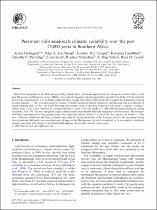 ResearchSpace
ResearchSpace
Persistent millennial-scale climatic variability over the past 25,000 years in Southern Africa
JavaScript is disabled for your browser. Some features of this site may not work without it.
- ResearchSpace
- →
- Research Publications/Outputs
- →
- Journal Articles
- →
- View Item
| dc.contributor.author |
Holmgren, K

|
en_US |
| dc.contributor.author |
Lee-Thorp, JA

|
en_US |
| dc.contributor.author |
Cooper, GRJ

|
en_US |
| dc.contributor.author |
Lundblad, K

|
en_US |
| dc.contributor.author |
Patridge, TC

|
en_US |
| dc.contributor.author |
Scott, L

|
en_US |
| dc.contributor.author |
Sithaldeen, R

|
en_US |
| dc.contributor.author |
Talma, AS

|
en_US |
| dc.contributor.author |
Tyson, PD

|
en_US |
| dc.date.accessioned | 2007-01-20T12:16:35Z | en_US |
| dc.date.accessioned | 2007-06-07T10:05:03Z | |
| dc.date.available | 2007-01-20T12:16:35Z | en_US |
| dc.date.available | 2007-06-07T10:05:03Z | |
| dc.date.copyright | en_US | |
| dc.date.issued | 2003-11 | en_US |
| dc.identifier.citation | Holmgren, K, et al. 2003. Persistent millennial-scale climatic variability over the past 25,000 years in Southern Africa. Quaternary Science Reviews, vol 22(21-22), pp 2311-2326 | en_US |
| dc.identifier.issn | 0277-3791 | en_US |
| dc.identifier.uri | http://hdl.handle.net/10204/1422 | en_US |
| dc.identifier.uri | http://hdl.handle.net/10204/1422 | |
| dc.description.abstract | Data from stalagmites in the Makapansgat Valley, South Africa, document regional climatic change in southern Africa in the Late Pleistocene and Holocene. A new TIMS U-series dated stalagmite indicates speleothem growth from 24.4 to 12.7 ka and from 10.2 to 0 ka, interrupted by a 2.5ka hiatus. High-resolution oxygen and carbon stable isotope data suggest that postglacial warming was first initiated ~17 ka, was interrupted by cooling, probably associated with the Antarctic Cold Reversal, and was followed by strong warming after 13.5ka. The Early Holocene experienced warm, evaporative conditions with fewer C4 grasses. Cooling is evident from ~6 to 2.5ka, followed by warming between 1.5 and 2.5ka and briefly at ~AD 1200. Maximum Holocene cooling occurred at AD 1700. The new stalagmite largely confirms results from shorter Holocene stalagmites reported earlier. The strongest variability superimposed on more general trends has a quasi-periodicity between 2.5and 4.0 ka. Also present are weaker ~1.0 ka and ~100-year oscillations, the latter probably solar induced. Given similarities to the Antarctic records, the proximate driving force producing millennial- and centennial-scale changes in the Makapansgat record is postulated to be atmospheric circulation changes associated with change in the Southern Hemisphere circumpolar westerly wind vortex. | en_US |
| dc.format.extent | 363270 bytes | en_US |
| dc.format.mimetype | application/pdf | en_US |
| dc.language.iso | en | en_US |
| dc.publisher | Pergamon-Elsevier Science Ltd | en_US |
| dc.rights | Copyright: 2003 Pergamon-Elsevier Science Ltd | en_US |
| dc.source | en_US | |
| dc.subject | Makapansgat valley - South Africa | en_US |
| dc.subject | Stalagmite conical mineral deposits | en_US |
| dc.subject | Holocene climatic epochs | en_US |
| dc.subject | Pleistocene climatic epochs | en_US |
| dc.subject | Geosciences | en_US |
| dc.title | Persistent millennial-scale climatic variability over the past 25,000 years in Southern Africa | en_US |
| dc.type | Article | en_US |
| dc.identifier.apacitation | Holmgren, K., Lee-Thorp, J., Cooper, G., Lundblad, K., Patridge, T., Scott, L., ... Tyson, P. (2003). Persistent millennial-scale climatic variability over the past 25,000 years in Southern Africa. http://hdl.handle.net/10204/1422 | en_ZA |
| dc.identifier.chicagocitation | Holmgren, K, JA Lee-Thorp, GRJ Cooper, K Lundblad, TC Patridge, L Scott, R Sithaldeen, AS Talma, and PD Tyson "Persistent millennial-scale climatic variability over the past 25,000 years in Southern Africa." (2003) http://hdl.handle.net/10204/1422 | en_ZA |
| dc.identifier.vancouvercitation | Holmgren K, Lee-Thorp J, Cooper G, Lundblad K, Patridge T, Scott L, et al. Persistent millennial-scale climatic variability over the past 25,000 years in Southern Africa. 2003; http://hdl.handle.net/10204/1422. | en_ZA |
| dc.identifier.ris | TY - Article AU - Holmgren, K AU - Lee-Thorp, JA AU - Cooper, GRJ AU - Lundblad, K AU - Patridge, TC AU - Scott, L AU - Sithaldeen, R AU - Talma, AS AU - Tyson, PD AB - Data from stalagmites in the Makapansgat Valley, South Africa, document regional climatic change in southern Africa in the Late Pleistocene and Holocene. A new TIMS U-series dated stalagmite indicates speleothem growth from 24.4 to 12.7 ka and from 10.2 to 0 ka, interrupted by a 2.5ka hiatus. High-resolution oxygen and carbon stable isotope data suggest that postglacial warming was first initiated ~17 ka, was interrupted by cooling, probably associated with the Antarctic Cold Reversal, and was followed by strong warming after 13.5ka. The Early Holocene experienced warm, evaporative conditions with fewer C4 grasses. Cooling is evident from ~6 to 2.5ka, followed by warming between 1.5 and 2.5ka and briefly at ~AD 1200. Maximum Holocene cooling occurred at AD 1700. The new stalagmite largely confirms results from shorter Holocene stalagmites reported earlier. The strongest variability superimposed on more general trends has a quasi-periodicity between 2.5and 4.0 ka. Also present are weaker ~1.0 ka and ~100-year oscillations, the latter probably solar induced. Given similarities to the Antarctic records, the proximate driving force producing millennial- and centennial-scale changes in the Makapansgat record is postulated to be atmospheric circulation changes associated with change in the Southern Hemisphere circumpolar westerly wind vortex. DA - 2003-11 DB - ResearchSpace DP - CSIR KW - Makapansgat valley - South Africa KW - Stalagmite conical mineral deposits KW - Holocene climatic epochs KW - Pleistocene climatic epochs KW - Geosciences LK - https://researchspace.csir.co.za PY - 2003 SM - 0277-3791 T1 - Persistent millennial-scale climatic variability over the past 25,000 years in Southern Africa TI - Persistent millennial-scale climatic variability over the past 25,000 years in Southern Africa UR - http://hdl.handle.net/10204/1422 ER - | en_ZA |





